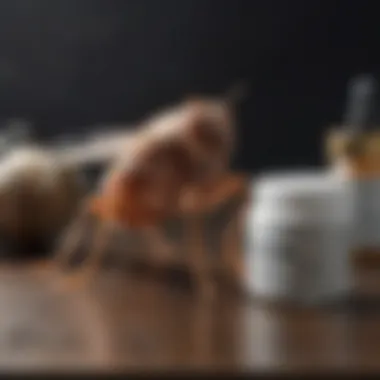Best At Home Flea Bomb: Effective Pest Control Guide


Intro
Flea infestations can pose a significant problem in homes, causing discomfort for both pets and humans alike. Understanding how to effectively combat these pests is crucial for maintaining a healthy living environment. This article focuses on at-home flea bombs, examining their efficacy, safety, and environmental concerns. Through proper pest management techniques and knowledge of flea biology, homeowners can make informed choices about flea control products, leading to a more pest-free home.
Understanding Pests
Definition of Pests
Pests are living organisms that are considered detrimental to human interests, usually due to their ability to cause harm to crops, property, or personal health. Fleas, for instance, are classified as external parasites that feed on the blood of mammals and birds. Their presence is often detected by itching or scratching in pets and painful bites in humans. Recognizing pests is the first step toward controlling them effectively.
Importance of Pest Identification
Identifying fleas accurately is key to implementing appropriate control measures. Fleas have a unique life cycle that includes egg, larva, pupa, and adult stages. Each of these stages requires specific treatment strategies. Recognizing these stages allows homeowners to choose the right products and methods, ensuring that all life stages are addressed during treatment.
Effective Flea Bomb Solutions
Understanding Flea Bomb Mechanics
An at-home flea bomb, also known as a fogger, releases a pesticide mist throughout a space, helping to eliminate adult fleas, larvae, and, to some extent, eggs. The effectiveness of a flea bomb hinges on proper usage methods.
"Always follow the product instructions for optimal coverage and safety."
Evaluating Safety and Effectiveness
When selecting a flea bomb, several factors warrant consideration:
- Ingredients: Some products contain harsh chemicals, while others use less aggressive compounds.
- Safety: Assess if the product is pet-friendly and safe for household members.
- Covering all spaces: Ensure proper fogging to reach all areas, especially under furniture.
Prevention Techniques
Home and Garden Preventative Measures
It is crucial to maintain cleanliness in your home to prevent flea infestations. Regular vacuuming, especially in areas frequented by pets, will help eliminate flea eggs and larvae. Additionally, washing pet bedding and soft furnishings in hot water can disrupt the flea life cycle.
Outdoor spaces can also be treated. Keeping your yard tidy by mowing the lawn frequently and minimizing leaf litter can reduce potential flea habitats.
Seasonal Prevention Tips
Flea populations often surge during warm months. Being proactive is important. Key strategies include:
- Regular grooming: Brush your pets regularly, especially during warmer months.
- Use preventive treatments: Apply topical flea treatments or collars, particularly before peak flea season.
- Monitor for fleas: Keep a watchful eye on your pets' behavior when they return from outdoors.
Eco-Friendly Pest Control Solutions
Overview of Sustainable Practices
For those concerned about the environmental impacts of chemical pest control, eco-friendly solutions are available. Many households are turning to natural pesticides and non-toxic methods for flea management. Natural remedies can be less harmful, reducing the risk to pets and children.
Natural Remedies and Their Effectiveness
Some effective natural remedies include:
- Diatomaceous earth: This powder can be sprinkled in areas where fleas are suspected; it is safe for pets and humans but lethal to fleas.
- Essential oils: Certain oils like lavender or cedar can repel fleas. Be careful to dilute them properly, as concentrated oils can harm pets.
Understanding Flea Infestations
Understanding flea infestations is crucial for developing effective pest control strategies. Fleas pose significant health risks. They can transmit diseases and cause discomfort for both pets and humans. Recognizing the signs of infestation early is vital for managing the problem before it escalates. Fleas reproduce quickly, and an unchecked population can become overwhelming.
Recognizing Flea Problems
Recognizing flea problems starts with understanding the symptoms. Pets often display signs of flea irritation, such as excessive scratching or biting. You might also notice flea dirt, which resembles tiny black specks in pet fur or on your floors. If you see these signs, it’s essential to inspect your home thoroughly. Check places where your pets spend a lot of time. Fleas can hide in carpets, bedding, and fabrics.
Lifecycle of Fleas
The lifecycle of fleas plays a vital role in understanding infestations. A flea's lifecycle consists of four stages: egg, larva, pupa, and adult. Fleas lay eggs on hosts, and these eggs fall into the environment. Once the eggs hatch, larvae emerge, feeding on organic matter and flea feces. The larvae then spin a cocoon. The adult flea emerges from the cocoon when it detects a host nearby, leading to a rapid increase in the flea population. This lifecycle duration can vary based on environmental conditions, making it challenging to kill all fleas with one treatment.


Identifying Common Flea Species
Identifying common flea species helps tailor control measures effectively. The most common types include the cat flea, dog flea, and oriental rat flea. The cat flea is the most prevalent, often found on both cats and dogs. The dog flea mainly infests dogs but can also affect cats. The oriental rat flea is usually associated with rodents but can affect pets as well. Understanding these species will assist in determining the best control methods and products for your specific situation.
The Role of Flea Bombs in Pest Control
Flea bombs are an essential tool in the arsenal against pest infestations. They provide an effective means to combat fleas within homes, especially when traditional methods may not be sufficient. Understanding their role involves recognizing how they work, their benefits, and the necessary considerations for their safe and effective use.
Function and Mechanism of Flea Bombs
Flea bombs operate by releasing a fine mist of their active ingredients. This mist penetrates into areas that are otherwise difficult to reach, such as cracks in floors, upholstery, and pet bedding. The bombs typically contain chemicals like pyrethrins or other insecticides that target the nervous system of the fleas, eliminating them effectively. The fog created ensures that the pesticide disperses throughout the treated areas, reaching both adult fleas and larvae, which is crucial for breaking the reproduction cycle.
Benefits of Using Flea Bombs
Using flea bombs comes with several advantages:
- Comprehensive Coverage: The aerosol nature of flea bombs allows for distribution in hard-to-reach places, ensuring a more thorough extermination compared to spot treatments.
- Time Efficiency: Application is straightforward and quick, often requiring little preparation. This efficiency appeals to busy homeowners.
- Fast-Acting: Many flea bombs are designed for rapid results, eliminating visible flea populations soon after application.
- Less Physical Effort: Compared to vacuuming or scrubbing, bombing an area requires minimal physical labor, making it a practical option for those with limited mobility.
Limitations and Considerations
Despite their effectiveness, flea bombs have limitations and important safety considerations:
- Chemical Exposure: The pesticides used can pose health risks to humans and pets if proper precautions are not adhered to. This includes evacuating the premises during treatment and ensuring thorough ventilation afterward.
- Limited Efficacy on Large Infestations: If the flea infestation is severe, a flea bomb alone may not suffice. It is often best used in combination with other methods, such as vacuuming and treating pets.
- Residue Concerns: After use, some flea bombs can leave behind chemical residue. It's crucial to clean surfaces that may come into contact with children and pets.
- Specificity of Treatment: Not all flea bombs target every life stage of fleas. Homeowners must ensure that the chosen product addresses both adults and larvae effectively.
It’s important to carefully read the instructions and safety warnings that come with flea bomb products to ensure successful application and minimize any potential hazards.
By understanding the role of flea bombs, homeowners can better prepare for addressing potential flea problems in their homes.
Evaluating the Best At-Home Flea Bombs
Finding the right flea bomb for home use is not just about tackling a ticklish problem or managing an annoying pest. It is a critical step in ensuring a healthier living environment. Flea infestations can lead to multiple consequences, from pet discomfort to potential health risks for humans. Therefore, understanding the various aspects of at-home flea bombs can help effective decision making in pest control.
When it comes to evaluating at-home flea bombs, key elements come into play. These elements include brand reputation, active ingredients, ease of use, and consumer feedback. Each holds significance in choosing a product that provides not only efficacy but also safety. Moreover, considering how these bombs interact with your home's environment is essential.
The selection process requires careful analysis. A deeper understanding of options helps home owners to take calculated steps toward ensuring effective pest control while maintaining health and safety standards.
Top Brands in the Market
Several brands dominate the market with reputed flea bomb products. Notable among them are Hot Shot, Raid, and Advantage. These brands have proven to offer effective solutions for flea infestations.
Hot Shot, for example, is well-regarded for its powerful insecticide formulation which effectively targets fleas at various stages of their lifecycle. Similarly, Raid presents a range of products that provide both immediate and long-term pest control. On the other hand, Advantage sometimes offers family-oriented formulas, which are based on ease of application and safety for households.
Picking a recognized brand can generally ensure better quality. Established brands invest in research and development to enhance product effectiveness and safety.
Key Ingredients to Look For
What goes into a flea bomb can vary significantly. Some critical ingredients are essential to evaluate when selecting a flea bomb. Here are a few to consider:
- Pyriproxyfen: This ingredient disrupts flea growth, effectively preventing larvae from developing into adult fleas.
- Prallethrin: This is often included for quick knockdown of adult fleas, providing immediate results.
- Boric Acid: A natural option, boric acid targets various insects and has proven effectiveness against fleas.
- S-methoprene: A commonly used growth regulator, it plays a crucial role in halting the flea lifecycle.
Always check the label for these ingredients as they contribute to the effectiveness of flea bombs.
Consumer Feedback and Ratings
The voice of the consumer is invaluable in evaluating flea bombs. Looking at reviews and ratings across platforms can provide insight into a product's real-world effectiveness.
Many users often comment on ease of use, smell, and long-lasting effects. Products that receive rave reviews usually have straightforward instructions and minimal lingering odors. Furthermore, feedback can highlight any particular issues that less effective products may have, such as poor distribution or failure to eliminate fleas.
"User reviews can be a goldmine, revealing the real-life implications of using a specific product."
Consider checking forums and online marketplaces for aggregated feedback. This data can guide you toward making an informed decision.
Safety Considerations When Using Flea Bombs
Using flea bombs is a popular method for managing flea infestations, but safety considerations are paramount. While these products can be highly effective, they contain chemicals that can pose health risks if not used properly. Understanding the importance of safety is essential for homeowners to protect themselves, their pets, and their environment.
Health Implications of Chemical Use


Flea bombs work by dispersing insecticides throughout the room, targeting adult fleas and their larvae. However, many of these chemicals can have adverse health effects. Prolonged exposure may cause respiratory issues, skin irritations, or other health problems. It is vital to read labels and understand the content of the flea bomb used.
Some common chemicals include pyriproxyfen and tetramethrin, which, although effective, may pose risks to vulnerable populations like children and pets. Understanding the potential side effects helps in making an informed decision before using these products.
Safety Precautions to Implement
To minimize risks when using flea bombs, certain precautions should be implemented:
- Vacuum Thoroughly: Before deploying the flea bomb, vacuum carpets, furniture, and other areas. This removes fleas and their eggs, enhancing the efficiency of the treatment.
- Seal the Area: Close all windows and doors to contain the insecticide within the treatment area. This also includes any gaps that might allow the chemicals to escape.
- Remove Pets and Humans: Ensure that all living beings, including pets, are removed from the treated area. Follow the manufacturer’s guidelines on how long to keep the area vacated after treatment.
- Wear Protective Gear: Consider wearing gloves and a mask during application to reduce exposure to chemicals. This is especially important if you have respiratory problems or skin sensitivities.
By following these precautions, homeowners can better protect themselves and others from the potentially hazardous effects of flea bomb chemicals.
Post-application Safety Tips
After using a flea bomb, safety does not end. Certain steps should be taken to ensure the area remains safe:
- Air Out the Area: After the recommended time, ventilate the treatment area. Open windows and doors to allow fresh air to circulate and reduce residual chemical exposure.
- Wait Before Resuming Normal Activities: Follow guidelines regarding how long to wait before re-entering the treated space. It is generally advisable to wait at least several hours.
- Handle Pets with Care: When pets return, monitor them for any unusual behavior. If there are symptoms like excessive drooling or lethargy, consult a vet.
- Clean After Treatment: Once it is safe to re-enter, vacuum thoroughly again. This can help eliminate any lingering chemical residues and dead fleas.
Remember: Safety is a continuous process. Proper preparation, careful application, and thorough post-application steps are essential to minimize risks while effectively managing flea infestations.
Environmental Impact of Flea Bombs
Understanding the environmental impact of flea bombs is essential in today's ecosystem-conscious society. High awareness of chemical usage in pest control means homeowners need to consider both efficacy and the potential fallout from their pest control choices. This section will discuss the significant elements, benefits, and considerations concerning the environmental implications of flea bombs. An informed approach emphasizes balancing effective flea management while minimizing harm to the environment.
Eco-friendly Alternatives
Many homeowners opt for traditional flea bombs, but eco-friendly alternatives are gaining popularity. These methods do not contain harsh chemicals and are often derived from natural ingredients. Some notable eco-friendly options include:
- Diatomaceous Earth: This powdered substance targets fleas by dehydrating them upon contact.
- Essential Oils: Certain oils, such as lavender or peppermint, have repelling properties against fleas and can be used as a spray.
- Homemade Flea Sprays: Mixing vinegar and water can create a natural flea deterrent for pets and around the home.
- Beneficial Nematodes: These microscopic organisms can be introduced into outdoor spaces to naturally regulate flea populations.
These approaches not only control flea problems effectively but also promote a healthier environment for pets and families.
Comparative Analysis of Environmental Implications
When comparing traditional flea bombs with eco-friendly alternatives, several aspects come into play. Chemical Composition is a primary consideration. Standard flea bombs often use insecticides that can linger in the environment, posing risks to both human health and wildlife. In contrast, natural alternatives typically break down more quickly and leave fewer residues.
Another crucial factor is the application method. Flea bombs result in the release of chemicals into the air, which can have a wider impact on air quality. In contrast, methods such as sprays or dusts can be applied more carefully.
"Understanding the environmental impact of pest control methods is not just about immediate effectiveness; it is about the long-term health of our ecosystems."
Additionally, sustainability is a pivotal discussion in pest control. Eco-friendly options tend to emphasize sustainable practices. This shift away from conventional methods signals a growing consumer demand for products that prioritize environmental health.
Finally, evaluating the cost-effectiveness of these alternatives is also vital. Initially, eco-friendly solutions may seem more expensive, but their long-term benefits, including reduced environmental damage and improved health outcomes, frequently prove to be more valuable in the end.
Implementing Flea Bomb Treatment in the Home
Implementing flea bomb treatment is a pivotal step in tackling flea infestations within the home. Understanding its intricacies can greatly influence the outcome of your pest control efforts. Flea bombs are designed to disperse insecticides throughout a given area, effectively targeting adult fleas and their larvae. This method's effectiveness hinges on prior preparation, proper deployment, and follow-up procedures that ensure residual effects and minimize re-infestation risks.
The benefits of flea bomb treatments include reaching hidden areas where fleas commonly reside, such as carpets, upholstery, and cracks in the flooring. However, these treatments also need careful planning and execution to maximize their efficacy. Homeowners should prioritize thorough preparation, which lays the groundwork for a successful application.
Preparation Steps Before Treatment
Preparation is crucial before deploying a flea bomb. It sets the stage for maximized effectiveness and safety. Here are key steps to follow:
- Remove Pets: All pets must leave the treated area, ideally for at least a few hours. Flea bombs release insecticide that can be harmful to them.
- Clear the Space: Remove food items, dishes, and personal belongings from the area being treated. This minimizes contamination and exposure to chemicals.
- Vacuum Thoroughly: Vacuum all carpets, rugs, and upholstered furniture. This action helps to remove adult fleas and eggs, making the bomb treatment more effective.
- Seal Cracks and Gaps: Ensure that windows and doors are closed tightly. This will prevent the insecticide from escaping and enhance its distribution.
- Read the Instructions: Each flea bomb product may vary in application. Reviewing instructions ensures adherence to specific guidelines.
Proper preparation can make a significant difference in the results achieved with flea bomb treatment.
How to Effectively Deploy a Flea Bomb
When deploying a flea bomb, following specific steps can enhance its effectiveness:
- Choose the Right Time: Select a time when you are able to vacate the area for the recommended duration.
- Prime the Bomb: Shake the flea bomb as instructed to mix the chemicals effectively.
- Position the Device: Place the flea bomb in the center of the room or on a flat surface. Ensure it is away from drafts or areas where it could tip over.
- Activate the Bomb: Inactivate the device according to the product’s guidelines. Be sure to vacate the premises immediately after activation.
- Close Off the Area: Ensure that the room is closed off, including doors, to contain the insecticide and create a controlled environment for treatment.
Following these steps closely can optimize the bomb’s effectiveness and improve your chances of eliminating fleas from the environment.
Cleaning and Follow-up Procedures


After treating the space with a flea bomb, cleaning and follow-up actions are essential for ensuring lasting results:
- Ventilate the Area: Open windows and doors to help dissipate any lingering chemical odor after the recommended waiting period.
- Thorough Cleaning: Once you have re-entered the space, vacuum all treated areas again. This will capture dead fleas and help eliminate any lingering eggs.
- Wash Fabrics: Any non-washable items should be cleaned according to the guidelines. Laundering bedding, toys, and other fabric items in hot water can help eliminate remaining fleas.
- Monitor for Re-infestations: Keep an eye on the area for a few weeks after treatment. Look for any signs of fleas reappearing, which could indicate a need for further treatment or a different pest control strategy.
Thorough cleaning and monitoring after treatment are vital for sustaining a flea-free home.
Implementing flea bomb treatment is a critical process that requires diligence in preparation, execution, and follow-up. By following these guidelines, homeowners can effectively reclaim their spaces from flea infestations.
Alternative Pest Control Methods
In the pursuit of effective flea management, alternative pest control methods offer various ways to address infestations without relying solely on conventional chemical treatments. These alternatives can provide significant benefits for homeowners looking for safer, sustainable solutions while still achieving effective results. It is essential to recognize that fleas are not just a nuisance; they can impact household health and well-being. This section will explore some viable options for natural remedies and professional services in detail.
Natural Remedies for Flea Control
Natural remedies can be an appealing choice for those wishing to minimize chemical exposure in their homes. These methods, while possibly less forceful than their chemical counterparts, provide a gentler approach to flea management.
Here are some commonly used natural remedies:
- Diatomaceous Earth: This is a natural substance made from the fossilized remains of tiny aquatic organisms. Sprinkling food-grade diatomaceous earth in areas where fleas are likely to hide may effectively dehydrate them. Remember to use it cautiously, as it can be harmful if inhaled.
- Essential Oils: Certain essential oils like lavender, cedarwood, and eucalyptus posses insect-repelling properties. Mixing a few drops with water in a spray bottle and applying this solution around the house can deter fleas. However, it is essential to do a patch test and be cautious around pets, as some oils can be toxic to animals.
- Apple Cider Vinegar: Combining equal parts of apple cider vinegar and water can create a natural flea repellant. Spraying this mixture on pet fur can help repel fleas, though caution should be exercised to avoid sensitive areas like the eyes.
- Salt: Salt can act as a dehydrator to fleas. Sprinkling salt on carpets and letting it sit for several hours before vacuuming can help kill adult fleas and eggs.
These natural methods tend to have fewer side effects and may be suitable for households that want to tread lightly when it comes to chemical treatment.
Professional Pest Control Services
When a flea infestation becomes overwhelming or hard to manage through DIY efforts, enlisting the help of professional pest control services might be necessary. This option brings expertise and specialized equipment to effectively deal with fleas at all lifecycle stages.
Professional services typically offer various treatments, including:
- Insect Growth Regulators: These substances disrupt the lifecycle of fleas, preventing them from maturing and reproducing. Professionals often apply these as part of a comprehensive strategy.
- Targeted Spraying: Pest control experts have access to commercial-grade insecticides that might not be available to the public. Their ability to apply these in specific, effective ways can yield quicker results.
- Integrated Pest Management: This holistic approach considers multiple factors contributing to infestations and combines multiple techniques to formulate the most effective treatment strategy. It reduces dependency on any one method and promotes long-term flea management.
"Utilizing professional pest control services can significantly expedite the process of removing fleas, ensuring a thorough and long-lasting solution."
Future Trends in Flea Control Solutions
The topic of future trends in flea control solutions is increasingly becoming relevant. As the dynamics of pest management evolve due to environmental concerns and advances in technology, understanding these trends provides insight into more effective methods for controlling flea infestations. With rising awareness about the impact of traditional pesticide use on health and the environment, there is a growing need to explore innovative solutions that are not only efficient but also sustainable.
Innovations in Pest Control Technology
Recent years have seen significant innovations in pest control technology. These advancements aim to provide homeowners with better tools and methods for managing flea infestations. For instance, smart traps that utilize sensors to detect flea activity are now available. These devices can alert you through apps, allowing for timely action. This technology minimizes unnecessary pesticide use and targets treatment more effectively.
Furthermore, the development of biological controls has also gained momentum. These controls involve the use of natural predators to manage flea populations. For instance, beneficial nematodes can infect and eliminate flea larvae, providing a more environmentally friendly approach.
With these advancements, the effectiveness and safety of flea control methods improve. Homeowners can take control of pest situations armed with better information and technology, leading to a more personalized pest management strategy.
Shifts Towards Sustainable Practices
As public attitude leans towards more sustainable practices, the flea control industry is also adapting. Consumers are increasingly looking for eco-friendly solutions in their pest management strategies. This shift promotes the development of products that reduce environmental harm while maintaining effectiveness.
Sustainable practices include the use of plant-based ingredients in flea control products. These alternatives are less harmful to humans and pets and pose lower risks to the ecosystem. Companies now emphasize transparency in their formulations, providing information about pesticide residuals and the safety of their ingredients.
Additionally, practices such as integrated pest management (IPM) are becoming common. IPM combines ecological principles with practical pest control methods, focusing on long-term prevention. This approach reduces reliance on chemical treatments through strategies like habitat modification and regular monitoring.
"The future of flea control should not just focus on eradication, but on creating sustainable environments that prevent infestations in the first place."
As these trends take shape, homeowners are invited to rethink their pest control strategies. With new technologies, eco-friendly options, and sustainable practices on the rise, managing flea infestations can become a more informed and responsible endeavor. This evolution is essential for creating healthier homes and environments in the long run.
Epilogue
The conclusion of this article synthesizes essential aspects of using at-home flea bombs for effective pest control. The topic is crucial for homeowners who seek long-lasting solutions to flea infestations without compromising safety or environmental health. By understanding the mechanics of flea bombs, the role they play in eliminating fleas, and the safety considerations involved, one can make informed choices about pest control measures.
Key Takeaways
In summarizing the article, several key points emerge:
- Flea infestations can lead to discomfort for both pets and humans. Awareness of the problem is the first step.
- Learning about flea life cycles helps in timing treatments effectively. Understanding when fleas are most vulnerable is crucial.
- Flea bombs serve as a potent tool against fleas when used properly. They work by releasing insecticides that target adult fleas and disrupting the life cycle.
- Safety precautions must be taken to minimize health risks associated with chemical exposure. Proper preparation before bombing and thorough cleaning afterward are imperative.
- Considering eco-friendly alternatives is ever more relevant. Products should be chosen based on their impact not only on pests but on the environment as well.
Final Thoughts on Best Practices
Adopting best practices in flea control can lead to more effective outcomes. Here are recommendations for homeowners:
- Evaluate the specific flea situation in your home and choose a suitable bomb. Some products might have specific features that match your needs better.
- Follow all instructions on the product label. Dosing is critical, and deviations can lead to insufficient results or safety hazards.
- Consistency is key. Re-treating your home and maintaining preventive measures can stop future infestations.
- Keep informed on new developments in flea control. Whether it's new products or innovative techniques, staying updated can enhance the effectiveness of your strategies.
By considering each of these elements, homeowners can not only address current flea issues but also prevent future ones, promoting a more pest-free living environment.



